TCP J04291884+4354232 possible nova mag 10.2
-
Christophe Boussin
- Posts: 172
- Joined: Sun Aug 21, 2016 6:04 pm
Re: TCP J04291884+4354232 possible nova mag 10.2
Thank you very much Paolo !!
I hope the magnitude will remain stable for a "long time"...
Yes, indeed, despite the noise in the spectrum, it seems that the ratio I(5007)/I(4959) of the relative intensities of the [OIII] lines is roughly 3 !
I hope your sky will be clear soon !!
I'm curious to see what you can get at higher resolution !
Christophe
I hope the magnitude will remain stable for a "long time"...
Yes, indeed, despite the noise in the spectrum, it seems that the ratio I(5007)/I(4959) of the relative intensities of the [OIII] lines is roughly 3 !
I hope your sky will be clear soon !!
I'm curious to see what you can get at higher resolution !
Christophe
CBO (Newton 200 F/5 / Alpy600 / Atik 314L+ / Atik Titan + Mewlon 180 F/12 / LHIRES III 2400 / Atik 460EX / Atik 314 L+) @ ARAS database
-
Paolo Berardi
- Posts: 578
- Joined: Thu Sep 29, 2011 10:51 pm
Re: TCP J04291884+4354232 possible nova mag 10.2
Hi Christophe, your wish has been heard, thank you!  Yesterday the sky cleared up (very rare event during this time!) and I was able to observe the nova again.
Yesterday the sky cleared up (very rare event during this time!) and I was able to observe the nova again.
I think the h-alpha line is the only feature (not very well) accessible at medium resolution with my telescope. The nova is very faint now but, as you can see from your full optical spectrum, most of flux in the visual range is concentrated in this line. So, the line intensity peak is hundred times the continuum level (it is almost undetectable in my spectrum). Without this particular condition, a mag 16 target would have been off-limits for me (think for example of dwarf novae, their spectrum have usually very weak features over continuum).
The resulting profile is noisy. I hope this spectrum may be useful in some way...
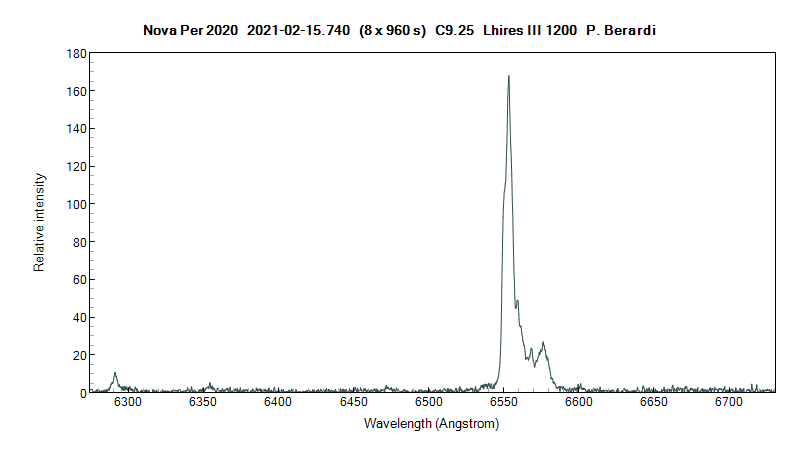
Velocity plot of h-alpha line, compared with 2 Feb profile.

Clear sky!
Paolo
I think the h-alpha line is the only feature (not very well) accessible at medium resolution with my telescope. The nova is very faint now but, as you can see from your full optical spectrum, most of flux in the visual range is concentrated in this line. So, the line intensity peak is hundred times the continuum level (it is almost undetectable in my spectrum). Without this particular condition, a mag 16 target would have been off-limits for me (think for example of dwarf novae, their spectrum have usually very weak features over continuum).
The resulting profile is noisy. I hope this spectrum may be useful in some way...

Velocity plot of h-alpha line, compared with 2 Feb profile.

Clear sky!
Paolo
-
Christophe Boussin
- Posts: 172
- Joined: Sun Aug 21, 2016 6:04 pm
Re: TCP J04291884+4354232 possible nova mag 10.2
Hi Paolo,
I'm very happy to have had a little influence on the sky of Italy !!
!!
A clear sky is a rare commodity to be appreciated these days...
Congratulations for your spectrum, very impressive that you were able to obtain this result at higher resolution !!
Yes, the relative intensity of the Halpha line is very high compared to the continuum and the others lines in the spectrum !
As you point out, this particular distribution of the luminous flux in the visible part of the spectrum allow us to access, without too much difficulty, to magnitude 16 !
I use this feature to position correctly, as much as possible, the nova in the slit.
On a single exposure of 60 seconds, only the Halpha line is visible.
So, I then correct the position of the nova on the slit by maximizing the flux on Halpha before starting exposures of 600 seconds.
On your spectra of January 18, February 2 and 15, I note that the relative intensity of the "blue" component of the Halpha line increases while that of the "red" component decreases.
I hope that the weather will be favorable for us to follow this evolution !
Maybe this weekend, here...
Christophe
I'm very happy to have had a little influence on the sky of Italy
A clear sky is a rare commodity to be appreciated these days...
Congratulations for your spectrum, very impressive that you were able to obtain this result at higher resolution !!
Yes, the relative intensity of the Halpha line is very high compared to the continuum and the others lines in the spectrum !
As you point out, this particular distribution of the luminous flux in the visible part of the spectrum allow us to access, without too much difficulty, to magnitude 16 !
I use this feature to position correctly, as much as possible, the nova in the slit.
On a single exposure of 60 seconds, only the Halpha line is visible.
So, I then correct the position of the nova on the slit by maximizing the flux on Halpha before starting exposures of 600 seconds.
On your spectra of January 18, February 2 and 15, I note that the relative intensity of the "blue" component of the Halpha line increases while that of the "red" component decreases.
I hope that the weather will be favorable for us to follow this evolution !
Maybe this weekend, here...
Christophe
CBO (Newton 200 F/5 / Alpy600 / Atik 314L+ / Atik Titan + Mewlon 180 F/12 / LHIRES III 2400 / Atik 460EX / Atik 314 L+) @ ARAS database
-
Paolo Berardi
- Posts: 578
- Joined: Thu Sep 29, 2011 10:51 pm
Re: TCP J04291884+4354232 possible nova mag 10.2
Excellent method, Christophe! This way you are confident you're working with the best throughput. Although strong, the line is too weak for me at R ~5000. So, I prefer to place the guide star (a field star) so that the nova disappears completely in the slit (I temporary increase a bit the guide camera exposure time to get a better view of the nova image halo).I use this feature to position correctly, as much as possible, the nova in the slit.
On a single exposure of 60 seconds, only the Halpha line is visible.
So, I then correct the position of the nova on the slit by maximizing the flux on Halpha before starting exposures of 600 seconds.
I hope the weather improves also for you!
Paolo
-
Forrest Sims
- Posts: 86
- Joined: Thu Feb 09, 2017 5:52 pm
Re: TCP J04291884+4354232 possible nova mag 10.2
HI All,
Here is my latest spectrum of Nova Per 2020. This is a single 900 sec exposure. As Paolo and Christophe have noted the target is very dim now. If it were not for the strong Halpha, Hbeta and some of the Oxygen emissions the star would be invisible with my telescope aperture. David Boyd measured the V mag at 16.0 the night before my spectrum. I used a similar technique as Paolo described, using 3 sec LodestarX2 guide exposures to move the target into the center of the slit (so that it disappears completely). And then quickly start autoguiding on a nearby star and with fingers crossed hoping for the best until you see the first image. I took 900 sec science exposures so it was a long wait but worth it as you can see in the following plots.
Nova Per 2020 with (9) 900 sec exposures. I have zoom in a bit in PlotSpectra to more clearly show the emission lines above the continuum.
And in this graph you can see the significant increase in the magnitude of emission lines and some new lines compared to a spectrum I took in January. I have made an attempt at line identification. Perhaps others can correct and or add lines? The "feature" at 5641Å is not real and sits exactly on one of my light pollution lines:(
Good weather to all!
Woody
Here is my latest spectrum of Nova Per 2020. This is a single 900 sec exposure. As Paolo and Christophe have noted the target is very dim now. If it were not for the strong Halpha, Hbeta and some of the Oxygen emissions the star would be invisible with my telescope aperture. David Boyd measured the V mag at 16.0 the night before my spectrum. I used a similar technique as Paolo described, using 3 sec LodestarX2 guide exposures to move the target into the center of the slit (so that it disappears completely). And then quickly start autoguiding on a nearby star and with fingers crossed hoping for the best until you see the first image. I took 900 sec science exposures so it was a long wait but worth it as you can see in the following plots.
Nova Per 2020 with (9) 900 sec exposures. I have zoom in a bit in PlotSpectra to more clearly show the emission lines above the continuum.
And in this graph you can see the significant increase in the magnitude of emission lines and some new lines compared to a spectrum I took in January. I have made an attempt at line identification. Perhaps others can correct and or add lines? The "feature" at 5641Å is not real and sits exactly on one of my light pollution lines:(
Good weather to all!
Woody
-
David Boyd
- Posts: 164
- Joined: Wed Dec 11, 2013 5:50 pm
Re: TCP J04291884+4354232 possible nova mag 10.2
From my B and V photometry of the nova, it appears that it has now recovered from the reddening episode which began as the nova faded around JD 2459225. Were the fading and reddening the result of dust emission?
David
David
-
Christophe Boussin
- Posts: 172
- Joined: Sun Aug 21, 2016 6:04 pm
Re: TCP J04291884+4354232 possible nova mag 10.2
Hello all,
Hi Paolo, your wish has also been heard and here I'm finally back as a team with Marion for a new spectrum of the nova Per 2020. I hope you will do the next one with higher resolution !
Hi Woody, congratulations for your very nice spectra !
I also hope that you can follow the nova for as long as possible with a much more favorable sky than mine !
As David noted, the magnitude of the Nova, still close to 16, now appears to be very slowly decreasing...
The following spectrum of the Nova Per 2020 was obtained the 27th of February at 19 h 08 TU with an Alpy 600 (resolution of 506, JJ = 2459273.2976) and an acquisition time of 90 min (9 x 600s) :
Due to the presence of the full moon, the acquisition conditions were much less favorable than on February 12th !!
Nevertheless, we can notice several notable changes in the spectrum ...
The double peak shape of the Halpha line is very obvious and seems to be visible in the Hbeta line as well. It's more difficult to say with the Hgamma line since it must be blended with the [OIII] line at 4363A...
The [OIII] lines at 4959 and 5007A are now clearly visible and the relative intensities of these lines have increased notably since February 12 !
Could it be that the NIII and CIII lines become visible ?
Clear skies,
Marion THOMAS et Christophe BOUSSIN
Hi Paolo, your wish has also been heard and here I'm finally back as a team with Marion for a new spectrum of the nova Per 2020. I hope you will do the next one with higher resolution !
Hi Woody, congratulations for your very nice spectra !
I also hope that you can follow the nova for as long as possible with a much more favorable sky than mine !
As David noted, the magnitude of the Nova, still close to 16, now appears to be very slowly decreasing...
The following spectrum of the Nova Per 2020 was obtained the 27th of February at 19 h 08 TU with an Alpy 600 (resolution of 506, JJ = 2459273.2976) and an acquisition time of 90 min (9 x 600s) :
Due to the presence of the full moon, the acquisition conditions were much less favorable than on February 12th !!
Nevertheless, we can notice several notable changes in the spectrum ...
The double peak shape of the Halpha line is very obvious and seems to be visible in the Hbeta line as well. It's more difficult to say with the Hgamma line since it must be blended with the [OIII] line at 4363A...
The [OIII] lines at 4959 and 5007A are now clearly visible and the relative intensities of these lines have increased notably since February 12 !
Could it be that the NIII and CIII lines become visible ?
Clear skies,
Marion THOMAS et Christophe BOUSSIN
CBO (Newton 200 F/5 / Alpy600 / Atik 314L+ / Atik Titan + Mewlon 180 F/12 / LHIRES III 2400 / Atik 460EX / Atik 314 L+) @ ARAS database
-
Paolo Berardi
- Posts: 578
- Joined: Thu Sep 29, 2011 10:51 pm
Re: TCP J04291884+4354232 possible nova mag 10.2
Hi all,
Woody, Christophe, Marion, very nice spectra! A great work has been done by all nova observers, as you can see from ARAS database. The Nova Per 2020 reached the highest number of spectra in DB after the "nova of the century", Nova Delphini 2013 (the same plateau phase at mag 11 against mag 16!).
In your last spectra the nebular lines growth is very clear.
Around 4640A there may be a blend of N III 4634.2, 4640.6 (often this line is stronger than 4634.2), 4641.9. C III 4647.4, 4650.2, 4651.4. But we need a specialist confirmation.
Very interesting (and providential) the recent brightness increase, albeit slight. It has allowed me to observe again the nova. This is the spectrum I took yesterday.
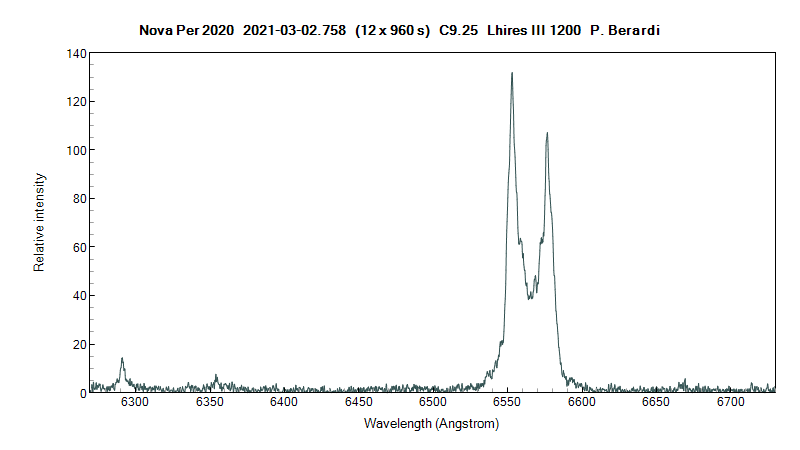
The red and blue peaks intensities are more similar than days before. Maybe that's why the line appears clearly double in low-res recent spectra.
In the following graph I grouped some observations spanning from 13/01 to 02/03 to show the h-alpha line development.
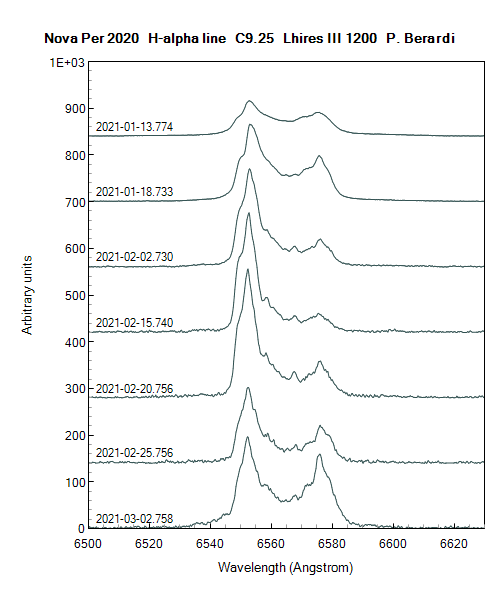
We'll see how the nova evolves...
Clear sky!
Paolo
Woody, Christophe, Marion, very nice spectra! A great work has been done by all nova observers, as you can see from ARAS database. The Nova Per 2020 reached the highest number of spectra in DB after the "nova of the century", Nova Delphini 2013 (the same plateau phase at mag 11 against mag 16!).
In your last spectra the nebular lines growth is very clear.
Around 4640A there may be a blend of N III 4634.2, 4640.6 (often this line is stronger than 4634.2), 4641.9. C III 4647.4, 4650.2, 4651.4. But we need a specialist confirmation.
Very interesting (and providential) the recent brightness increase, albeit slight. It has allowed me to observe again the nova. This is the spectrum I took yesterday.

The red and blue peaks intensities are more similar than days before. Maybe that's why the line appears clearly double in low-res recent spectra.
In the following graph I grouped some observations spanning from 13/01 to 02/03 to show the h-alpha line development.

We'll see how the nova evolves...
Clear sky!
Paolo
-
Paolo Berardi
- Posts: 578
- Joined: Thu Sep 29, 2011 10:51 pm
Re: TCP J04291884+4354232 possible nova mag 10.2
Hi all!
Tonight (noisy) spectrum
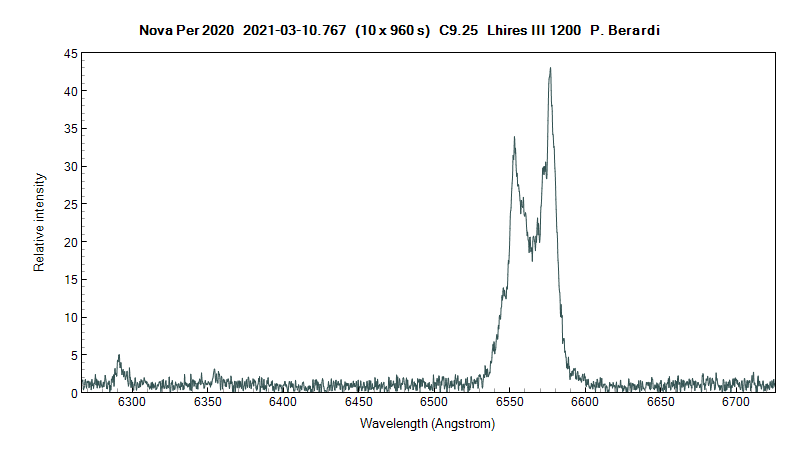
H-alpha emission line is constantly evolving. As seen in the 8 march profile by Etienne (database), red peak has become higher than blue peak.
Paolo
Tonight (noisy) spectrum

H-alpha emission line is constantly evolving. As seen in the 8 march profile by Etienne (database), red peak has become higher than blue peak.
Paolo
-
Paolo Berardi
- Posts: 578
- Joined: Thu Sep 29, 2011 10:51 pm
Re: TCP J04291884+4354232 possible nova mag 10.2
The feature appear clear also in recent low-res spectra in DB (Woody, Jean-Michel).
The updated stacked chart.
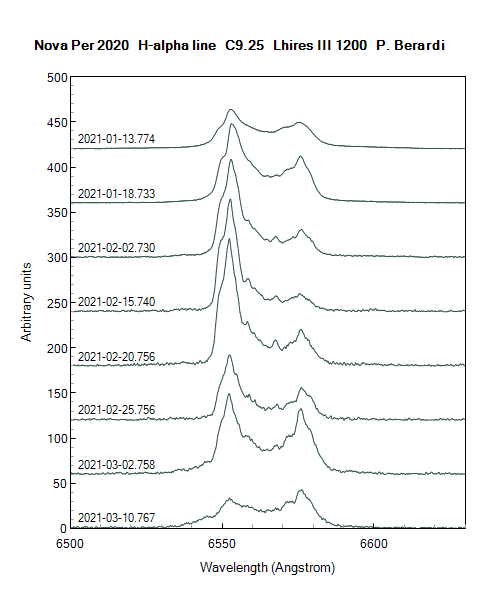
It seems that blue peak has decreases but without a "solid" continuum (lacking in my last spectra) I think it's difficult to evaluate...
Clear sky!
Paolo
The updated stacked chart.

It seems that blue peak has decreases but without a "solid" continuum (lacking in my last spectra) I think it's difficult to evaluate...
Clear sky!
Paolo